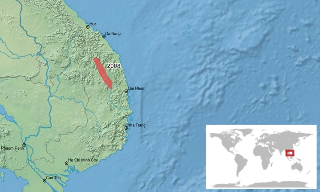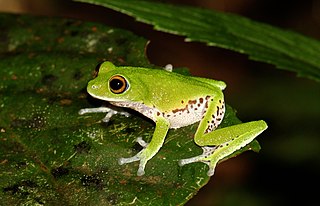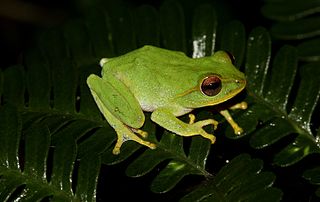
Philautus is a genus of shrub frogs in the family Rhacophoridae from Asia. Some species in this genus are now considered extinct by IUCN, while others are widespread and abundant. The taxonomy of the group is unclear, with many poorly described species.
Pelophryne rhopophilia, also known as lowland dwarf toad, is a species of toad in the family Bufonidae. It is endemic to Borneo and found in north-eastern and south-western Sarawak (Malaysia) and (likely) in adjacent West Kalimantan (Indonesia).
Leptobrachella palmata is a species of frog in the family Megophryidae. It is endemic to Borneo, and only known from its type locality in Lipaso Forest Reserve, Sabah, Malaysia. Common names palm Borneo frog and palm dwarf litter frog have been coined for it.

Leptobrachella tuberosa, also known as the granular toad, is a species of frog in the family Megophryidae. As currently known, it is endemic to the Central Highlands of Vietnam in Gia Lai, Quảng Nam, and Thừa Thiên–Huế Provinces. Its true range is probably wider as suitable habitat extends further north and east, reaching northeastern Cambodia and southeastern Laos. The specific name tuberosa is derived from the Latin tuberosus, meaning "full of protuberances".
Philautus abditus is a species of frog in the family Rhacophoridae. It is found in the highlands of central Vietnam as well as in extreme northeastern Cambodia. The specific name abditus is Latin for "hidden" or "concealed" and refers to the black spots on the legs that are concealed while the legs are flexed.
Philautus aurantium is a species of frog in the family Rhacophoridae. It is endemic to Borneo and found in the Mount Kinabalu region in Sabah and Sarawak, Malaysia. Philautus gunungensis is sometimes considered its subspecies, Philautus aurantium gunungensis.

Philautus bunitus is a species of frog in the family Rhacophoridae. It is endemic to Malaysian Borneo and inhabits subtropical or tropical moist lowland forests and subtropical or tropical moist montane forests and is threatened by habitat loss.

Pseudophilautus decoris, commonly known as the elegant shrub frog, is a species of frogs in the family Rhacophoridae. It is endemic to Sri Lanka.
Philautus disgregus, the disparate bubble-nest frog, or Malaysian bubble-nest frog is a species of frog in the family Rhacophoridae. It is endemic to Malaysia, where it has been observed as high as 300 meters above sea level.
Philautus erythrophthalmus is a species of frog in the family Rhacophoridae. It is endemic to Malaysia. People have seen it between 1,000 and 1,550 m meters above sea level.

Raorchestes griet is a species of frog in the family Rhacophoridae. It is endemic to the Western Ghats south of the Palghat Gap in Kerala and Tamil Nadu states, India. The specific name griet honours Griet Decock, spouse of Franky Bossuyt, the scientist who described the species. The common name Griet bush frog has been coined for it.
Philautus ingeri is a species of frog in the family Rhacophoridae. The species is endemic to northern Borneo, where it is found in Sabah, Sarawak, Brunei, and adjacent northern Kalimantan (Indonesia). The common names Inger's bush frog and Inger's bubble-nest frog have been coined for it. It is named for Robert F. Inger, American zoologist from the Field Museum of Natural History.

Pseudophilautus mooreorum, commonly known as Moore's shrub frog, is a species of frog in the family Rhacophoridae. It is endemic to Sri Lanka.

Pseudophilautus rus, known as Kandian shrub frog is a species of frog in the family Rhacophoridae.

Pseudophilautus stuarti, known as Stuart's shrub frog, is a species of frogs in the family Rhacophoridae. It is endemic to Sri Lanka. It was first formally observed in Corbett's Gap in the Knuckles Mountain Range, 1249 meters above sea level.
Philautus umbra is a species of frog in the family Rhacophoridae. It is endemic to Borneo and only known from Mount Api in northern Sarawak, Malaysia, although it might also occur in the adjacent Brunei.

Pseudophilautus viridis, or the dull-green shrub frog, is a species of frogs in the family Rhacophoridae. It is endemic to Sri Lanka and occurs in the central hills of south-central Sri Lanka.

Philautus everetti is a species of frog in the family Rhacophoridae found in the Philippines and Malaysia. Its natural habitats are subtropical or tropical moist lowland forests, subtropical or tropical moist montane forests, and rivers. In Borneo, this species occurs in the mountainous area from Gunung Kinabalu National Park in Sabah to Gunung Mulu National Park in Sarawak. It is usually observed between 750 and 1800 meters above sea level, but it is rarely seen as low as 300 meters above sea level.

Raorchestes dubois or the Koadaikanal bush frog is a species of frog in the family Rhacophoridae.
Philautus davidlabangi, or David Labang's bush frog, is a species of frog in the family Rhacophoridae. It is endemic to Malaysia, where it has been observed in the Cardamon Mountains, 859 meters above sea level at one site and between 165 and 330 meters above sea level at another.











